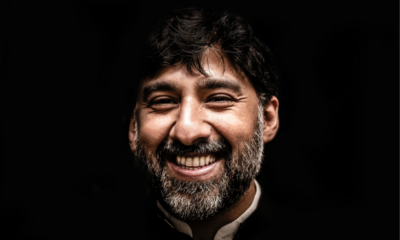Life
9 Strategies to Stop Chasing Happiness and Start Creating Happiness
Transforming our role from chaser to creator makes our lives meaningful again.

“I want to be happy.”
Ask someone what they want, and that’s the answer ninety-nine times out of one hundred.
It was one of my answers, along with freedom.
It’s a solid-sounding response that’s hard to argue with; who doesn’t want to be happy?
Only one problem, it’s not a solid answer; it’s vague and empty.
We must understand that happiness comes in different flavors to answer the question meaningfully.
Understanding how to create harmony between the two forms of happiness below is critical to living a rich and meaningful life.
The two flavors of happiness we need to understand are:
Hedonic Happiness & Eudaimonic Happiness.
Hedonic happiness is achieved through experiences of pleasure and enjoyment.
It refers to the sort of pleasure or happiness that we derive from doing what we like or avoiding doing what we don’t like.
Two common examples of hedonic pleasure are sex and food.
Eudaimonic happiness is achieved through experiences of meaning and purpose.
Examples are:
- Time with family.
- Experiencing awe and wonder.
- Having a mission and taking consistent action.
- Being of service.
- Serving something more significant than yourself.
Both are wickedly important to the quality of our lives.
However, most of us tend to lean too heavily on hedonic happiness.
Why?
Because it’s easier and what we’ve been conditioned to do.
When we lean too heavily on hedonic happiness, we consistently seek out the next hit and the subsequent rush; our overall well-being is abdicated to externals.
Hedonic happiness is short-lived, and when that’s the only form of happiness we pursue, we become chasers.
We chase money, status, and dopamine highs from social media, porn, or binging on shows.
There’s nothing inherently wrong with any of these activities.
There is, however, something wrong with them if we feel like our lives lack meaning and purpose.
Because when we feel as though our lives lack meaning and purpose, we feel empty inside, even if we have financial and materialistic success.
It’s like a success-sized hole in our lives, and the relentless chase of hedonic happiness will only widen the hole.
Hedonic happiness is like throwing sand in a sieve if we feel empty and our lives lack meaning and purpose.
This is why it’s so important to understand the forms of happiness and the importance of harmony.
Eudaimonic happiness is more challenging; it requires awareness, intention, and breaking free from a life set to autopilot.
It requires we ease off the pursuit of short-term pleasure seeking.
Eudaimonic happiness is a long game; it requires long-term thinking.
The cool thing about eudaimonic happiness is that it’s sticky.
Meaning after the experience is over, the feeling of meaning, purpose, and fulfillment sticks around.
It ripples out to all areas of life and makes life richer and more profound; it creates an extraordinary life story and is what creates a legacy.
Eudaimonic happiness leaves a mark on the soul.
Eudaimonic happiness isn’t chased; it’s created.
We create a life worth living by shifting the paradigm and introducing more actions that produce eudaimonic happiness.
So how do we shift toward eudaimonic well-being?
Here are 9 simple strategies to do just that.
- Seek flow states.
- Value your physical and mental health.
- Appreciate and cultivate your deep connections.
- Know your values and aspire to live a value-driven life.
- Reflect on classical virtues that speak to you and put them into action.
- Aim for harmony, don’t banish hedonic pleasure from your life completely.
- Be clear about your long-term goals and aim to take daily steps toward them.
- Experience beauty, awe, and wonder in nature, museums, or novel activities.
- Aspire to do good, to serve something bigger than yourself. Bonus: Feeling good will follow.
The goal is not to eliminate hedonic activities; that’s unrealistic and unhealthy.
There are two primary goals:
- Identify the hedonic activities that suck the energy out of you, that don’t serve your long-term vision for your life, and that when you’re done with them, you wish you had your time back.
- Replace those activities with eudaimonic activities so you can fill the success-sized hole in your life with mission, meaning, purpose, and fulfillment.
A great place to start the journey is by asking,
“When was the last time you felt fully alive?”
We must sit with this question in quiet reflection.
What exactly were you doing?
Where were you? Who were you with? Engage all the senses, sight, sound, touch, and smell.
When we experience this moment in exquisitely rich detail in our minds, we can analyze it precisely.
What was significant about that moment?
What can you learn from this experience?
Which core ingredients for flourishing can be extracted from that scene?
When we explore this question in a meaningful way, we reconnect with ourselves and open up a new way of thinking.
One that allows us to cultivate harmony in our happiness by letting go of the chase and instead creating our happiness.
Transforming our role from chaser to creator makes our lives meaningful again.
Did You Know
How Skilled Migrants Are Building Successful Careers After Moving Countries
Behind every successful skilled migrant career is a mix of resilience, strategy, and navigating systems built for locals.

Moving to a new country for work is exciting, but it can also be unnerving. Skilled migrants leave behind familiar systems, networks, and support to pursue better job opportunities and a better future for their families. (more…)
Life
10 Research-Backed Steps to Create Real Change This New Year
This New Year could finally be the one where you break old patterns and create real, lasting change.

Every New Year, we make plans and set goals, but often repeat old patterns. (more…)
Life
9 Harsh Truths Every Young Man Must Face to Succeed in the Modern World
Before chasing success, every young man needs to face these 9 brutal realities shaping masculinity in the modern world.

Many young men today quietly battle depression, loneliness, and a sense of confusion about who they’re meant to be.
Some blame the lack of deep friendships or romantic relationships. Others feel lost in a digital world that often labels traditional masculinity as “toxic.”
But the truth is this: becoming a man in the modern age takes more than just surviving. It takes resilience, direction, and a willingness to grow even when no one’s watching.
Success doesn’t arrive by accident or luck. It’s built on discipline, sacrifice, and consistency.
Here are 9 harsh truths every young man should know if he wants to thrive, not just survive, in the digital age.
1. Never Use Your Illness as an Excuse
As Dr. Jordan B. Peterson often says, successful people don’t complain; they act.
Your illness, hardship, or struggle shouldn’t define your limits; it should define your motivation. Rest when you must, but always get back up and keep building your dreams. Motivation doesn’t appear magically. It comes after you take action.
Here are five key lessons I’ve learned from Dr. Peterson:
-
Learn to write clearly; clarity of thought makes you dangerous.
-
Read quality literature in your free time.
-
Nurture a strong relationship with your family.
-
Share your ideas publicly; your voice matters.
-
Become a “monster”, powerful, but disciplined enough to control it.
The best leaders and thinkers are grounded. They welcome criticism, adapt quickly, and keep moving forward no matter what.
2. You Can’t Please Everyone And That’s Okay
You don’t need a crowd of people to feel fulfilled. You need a few friends who genuinely accept you for who you are.
If your circle doesn’t bring out your best, it’s okay to walk away. Solitude can be a powerful teacher. It gives you space to understand what you truly want from life. Remember, successful men aren’t people-pleasers; they’re purpose-driven.
3. You Can Control the Process, Not the Outcome
Especially in creative work, writing, business, or content creation, you control effort, not results.
You might publish two articles a day, but you can’t dictate which one will go viral. Focus on mastery, not metrics. Many great writers toiled for years in obscurity before anyone noticed them. Rejection, criticism, and indifference are all part of the path.
The best creators focus on storytelling, not applause.
4. Rejection Is Never Personal
Rejection doesn’t mean you’re unworthy. It simply means your offer, idea, or timing didn’t align.
Every successful person has faced rejection repeatedly. What separates them is persistence and perspective. They see rejection as feedback, not failure. The faster you learn that truth, the faster you’ll grow.
5. Women Value Comfort and Security
Understanding women requires maturity and empathy.
Through books, lectures, and personal growth, I’ve learned that most women desire a man who is grounded, intelligent, confident, emotionally stable, and consistent. Some want humor, others intellect, but nearly all want to feel safe and supported.
Instead of chasing attention, work on self-improvement. Build competence and confidence, and the rest will follow naturally.
6. There’s No Such Thing as Failure, Only Lessons
A powerful lesson from Neuro-Linguistic Programming: failure only exists when you stop trying.
Every mistake brings data. Every setback builds wisdom. The most successful men aren’t fearless. They’ve simply learned to act despite fear.
Be proud of your scars. They’re proof you were brave enough to try.
7. Public Speaking Is an Art Form
Public speaking is one of the most valuable and underrated skills a man can master.
It’s not about perfection; it’s about connection. The best speakers tell stories, inspire confidence, and make people feel seen. They research deeply, speak honestly, and practice relentlessly.
If you can speak well, you can lead, sell, teach, and inspire. Start small, practice at work, in class, or even in front of a mirror, and watch your confidence skyrocket.
8. Teaching Is Leadership in Disguise
Great teachers are not just knowledgeable. They’re brave, compassionate, and disciplined.
Teaching forces you to articulate what you know, and in doing so, you master it at a deeper level. Whether you’re mentoring a peer, leading a team, or sharing insights online, teaching refines your purpose.
Lifelong learners become lifelong leaders.
9. Study Human Nature to Achieve Your Dreams
One of the toughest lessons to accept: most people are self-interested.
That’s not cynicism, it’s human nature. Understanding this helps you navigate relationships, business, and communication more effectively.
Everyone has a darker side, but successful people learn to channel theirs productively into discipline, creativity, and drive.
Psychology isn’t just theory; it’s a toolkit. Learn how people think, act, and decide, and you’ll know how to lead them, influence them, and even understand yourself better.
Final Thoughts
The digital age offers endless opportunities, but only to those who are willing to take responsibility, confront discomfort, and keep improving.
Becoming a man today means embracing the hard truths most avoid.
Because at the end of the day, success isn’t about luck. It’s about who you become when life tests you the most.
Change Your Mindset
The Four Types of Happiness: Which One Are You Living In?
Most people chase success only to find emptiness, this model reveals why true happiness lies somewhere else.

In a world driven by rapid technological growth and constant competition, many people unknowingly trade joy for achievement. (more…)
-

 Shift Your Mindset4 weeks ago
Shift Your Mindset4 weeks ago11 E’s That Define Every Great Leader And Why Most People Miss Them
-

 Did You Know3 weeks ago
Did You Know3 weeks agoThe Success Patterns You Inherited (And Didn’t Notice)
-

 Entrepreneurs3 weeks ago
Entrepreneurs3 weeks agoThe Essential Skills Every Entrepreneur Needs In 2026
-

 Business3 weeks ago
Business3 weeks agoThe Hidden Money Pit in Your Operations (and How to Use It)
-

 Change Your Mindset2 weeks ago
Change Your Mindset2 weeks agoHow to Turn Your Mind Into Your Greatest Asset (Instead of Your Enemy)
-

 Change Your Mindset2 weeks ago
Change Your Mindset2 weeks agoThe Silent Skill That Makes People Respect You Instantly
-

 Life1 week ago
Life1 week ago10 Research-Backed Steps to Create Real Change This New Year
-

 Tech1 week ago
Tech1 week agoWhat’s in a Name? How to Get Your Domain Right

























